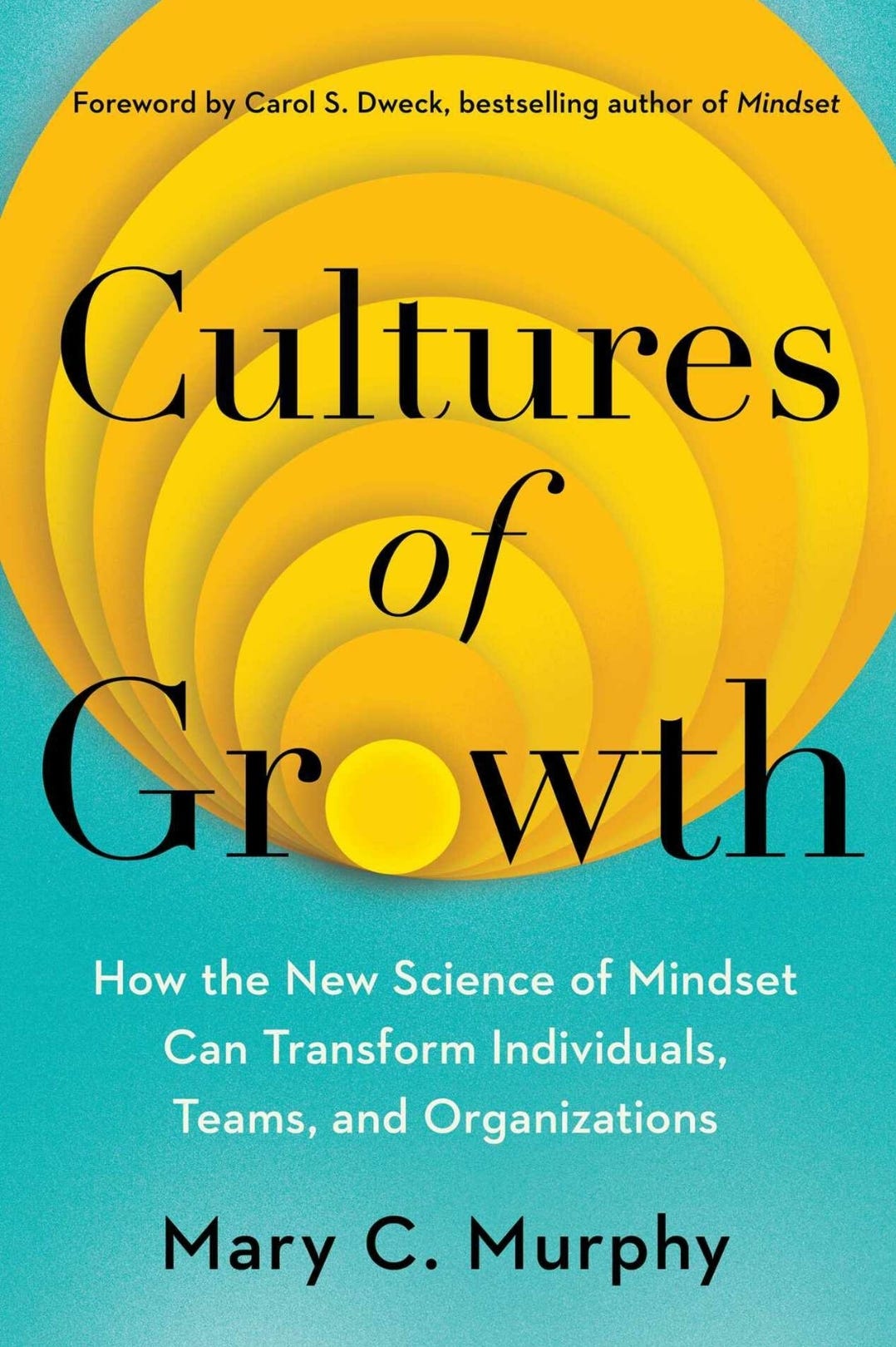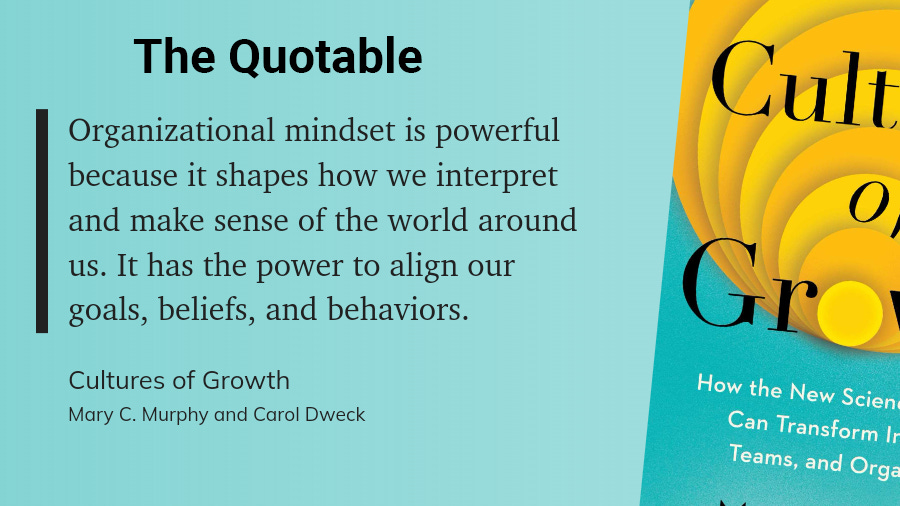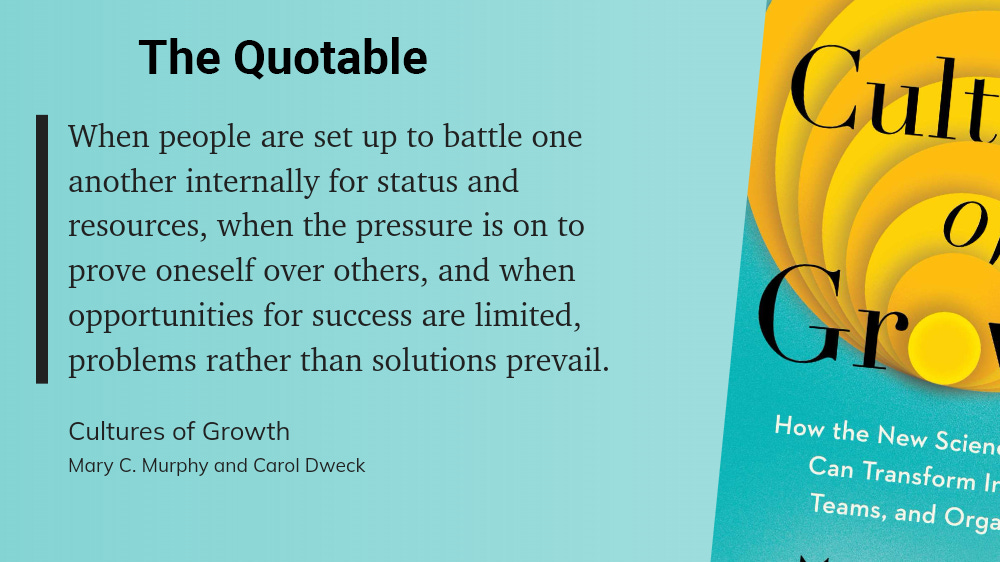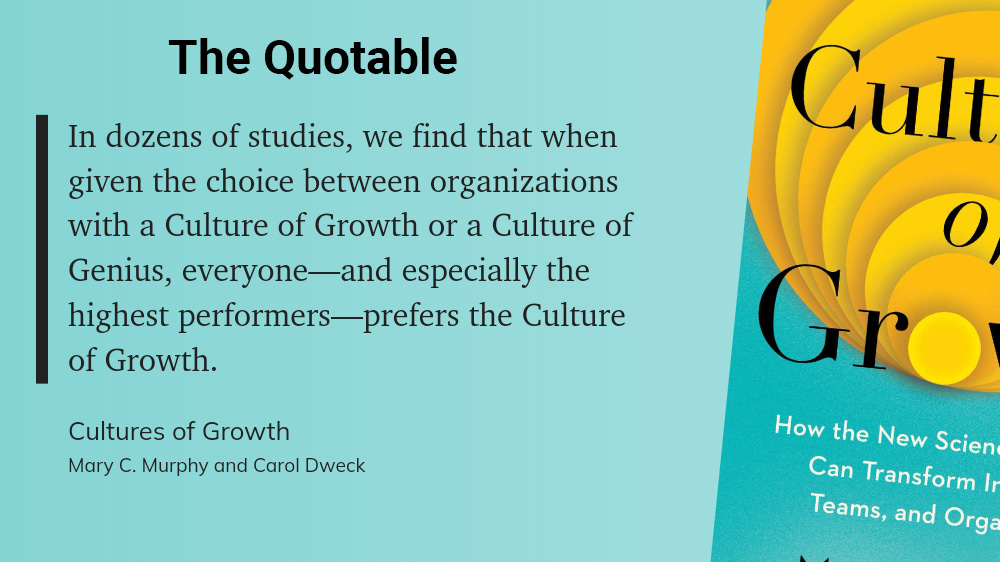S1 E2: Cultures of Growth
A Summable review of the book Cultures of Growth by Mary Murphy
In Cultures of Growth: How the New Science of Mindset Can Transform Individuals, Teams, and Organizations, Mary Murphy explores the impact of organizational culture on performance and personal well-being. While the concept of mindset in corporate environments isn't new, Murphy's treatment promises to rejuvenate the topic with actionable insights and fresh case studies that offer a roadmap to cultivating growth-oriented practices.
What is a Summable? It's a distilled essence of wisdom designed to navigate the oceans of information and insights with a compass of clarity and creativity.
In the 3 Summables below, you’ll discover the secret to groundbreaking innovation and soaring productivity aren’t about hustling harder or tapping into some mythical “genius gene,” but rather is found in the quiet corners of our daily interactions and the unspoken rules governing our office hallways. These insights will emerge in the following Summables:
Part 1: The Power of Mindsets
Part 2: Rethinking Competition
Part 3: Fostering Growth Microcultures
I’ve also included 3 sections of Ideas in Action to help explore practical application for those wanting to skill up on team and organizational development. Let’s dive in!
Part 1: The Power of Mindsets
The Essentials
The book contrasts two divergent workplace cultures: the Culture of Genius and the Culture of Growth. Throughout the first part of the book, a compelling narrative is told through the lens of an individual's first day at a new job. This story serves as a microcosm for exploring how mindset impacts organizational dynamics, performance, and innovation.
The Summable
Rather than rehashing the dichotomy of fixed and growth mindsets, Murphy invites readers to consider the nuanced manifestations of these mindsets in the workplace. Imagine a new recruit's first day in two hypothetical divisions of the same company — one in a "Culture of Genius" and the other in a "Culture of Growth." The stark contrast in the recruit's experiences serves as a case study that challenges readers to see mindset as more than a binary attribute. It prompts the fundamental question: how can companies cultivate growth within the rigidity of established systems?
The Culture of Genius, characterized by a fixed mindset, fosters an environment where innate talent is revered, and failure or the lack of immediate success is seen as a lack of ability. This culture often leads to a toxic workplace environment, stifling creativity and collaboration, and ultimately hampering growth and innovation.
Conversely, the Culture of Growth, underpinned by a growth mindset, values learning, development, and effort. In this culture, challenges are viewed as opportunities for development, and failure is not seen as a reflection of one's innate abilities but rather as a step in the learning process. This environment encourages risk-taking, collaboration, and innovation, leading to a dynamic and successful organization.
The transformation of Microsoft under CEO Satya Nadella exemplifies the shift from a Culture of Genius to a Culture of Growth, resulting in unprecedented success and innovation. Under Nadella's leadership, Microsoft embraced a culture of innovation and empowerment, encouraging intrapreneurship and growth. This strategy not only kept Microsoft at the forefront of technology but also attracted top talent keen on joining its transformative journey. This shift underscores the book's thesis: the type of culture an organization cultivates has profound implications on its overall performance and the well-being of its members.
The Hidden Gem
Mindset culture is dynamic, not fixed—continuously shaped by practices and interactions. This realization affirms that a shift towards a Culture of Growth is achievable for any individual or organization, regardless of their starting point.
Reflect and React:
Reflect on your current or past work environment. Can you identify if it leaned more towards a Culture of Genius or a Culture of Growth? How did this culture impact your work and well-being?
Consider a recent challenge or failure. How could a growth mindset approach alter your perception and response to similar situations in the future?
How can you foster a Culture of Growth within your sphere of influence, regardless of the overarching culture of your organization or team?
Part 2: Rethinking Competition
The Essentials
Murphy explores the negative effects of cutthroat competition, substantiated by emerging research on organizational health. This section examines business models that prioritize collaboration over rivalry, even in fiercely competitive industries, using less publicized success stories from organizations like Atlassian and Patagonia.
The Summable
Part 2 tackles the complex realm of mindset culture, particularly focusing on internal competition versus collaboration within organizations. Consider the merit raise distribution system in an academic setting. It’s easy to imagine this type of environment fostering intense competition among faculty members. This system, designed to reward productivity, inadvertently created a toxic environment, underscoring the broader theme of how competitive cultures can undermine collaboration and growth.
Internal competition in organizations can be detrimental. The origins of WeWork illustrated this negative impact of a competitive culture and the book underscores the high cost of prioritizing internal competition over collaboration. These costs include high employee turnover, reduced job satisfaction, and the potential erosion of an organization's competitive edge in the marketplace.
If internal competition can be costly, the more fruitful endeavor is exploring how organizations can thrive by fostering a Culture of Growth focused on collaboration. This is vividly demonstrated through case studies of companies like Atlassian and Patagonia, which have successfully cultivated collaborative environments that drive sustainable achievement without the collateral damage typical of Cultures of Genius.
The section challenges the reader to reconsider the role of competition. It argues that while competition may have its place, the path to lasting success and innovation lies in creating an environment where collaboration and growth are nurtured.
The Hidden Gem
Shifting from a competitive to a collaborative culture magnifies success without sacrificing drive. It channels individual ambitions into collective goals, fostering sustainable and significant achievements.
Reflect and React:
How does your current or past workplace culture impact your ability to take risks and innovate? How could you foster a more collaborative environment within your team or organization?
Reflect on a time when internal competition affected your work or team dynamics. What could have been done differently to encourage collaboration?
How can you contribute to a Culture of Growth in your professional or personal life, and encourage collaboration and growth in your surroundings?
Part 3: Fostering Growth Microcultures
The Essentials
Part 3 introduces the concept of mindset microcultures and how they emerge as an actionable strategy for instigating transformation from the ground up. This section is bolstered with under-the-radar case studies, like a regional bank's initiative to shift its branches' microcultures and the impact on customer satisfaction and employee engagement. The four mindset triggers (evaluative situations, high-effort situations, critical feedback, success of others) are illustrated through real-life scenarios, complete with metrics and measurements for tracking progress.
The Summable
The third installment of Cultures of Growth turns the spotlight onto mindset microcultures within larger organizational contexts. It shows how small teams or departments can cultivate growth mindsets even in environments predominantly characterized by a Culture of Genius. These microcultures are crucibles for innovation, resilience, and positive change, demonstrating that transformation towards a Culture of Growth is not only possible but practicable from within.
The narrative starts with exploring mindset triggers—evaluative situations, high-effort situations, critical feedback, and the success of others—and how responses to these triggers can lead to a fixed or growth mindset. The book argues that understanding and navigating these triggers is key to fostering a Culture of Growth, both at an individual and organizational level.
Through a combination of research findings and real-world examples, the book makes a compelling case for the power of growth mindset microcultures. For instance, the multinational bank's experiment, which identified the four mindset triggers, demonstrates how awareness of these triggers can enhance employee performance, motivation, and behavior. Similarly, the focus on Shell Oil and other companies highlights the universal applicability of these concepts across industries.
The Hidden Gem
Mindset microcultures are transformative pockets within large organizations, where a growth mindset thrives even amidst a prevailing Culture of Genius. This insight highlights the potential for profound change and growth at any organizational level.
Reflect and React:
Think about a recent evaluative situation you encountered. Did it trigger a fixed or growth mindset response in you? What could you do differently next time to foster a growth mindset?
Identify a "mindset microculture" within your organization or community. What makes it a conducive environment for growth? How can its principles be applied more broadly?
Consider the four mindset triggers. Which one do you find most challenging, and why? How can you prepare yourself to respond more positively to this trigger in the future?
A Great Book for...
Innovators and Entrepreneurs: Those creating disruptive solutions by embracing challenges and learning from failures.
Career Changers: Individuals navigating the uncertainties of a new professional path, armed with the belief in their ability to grow.
Team Leaders and Managers: Leaders wanting to cultivate an environment where risk-taking is encouraged, and failure is seen as a learning opportunity.
Lifelong Learners: Anyone committed to personal growth, eager to explore expanding their potential.
Throughout the book, readers engage with theoretical musings and evidence-based tools and frameworks needed to diagnose, intervene, and innovate within their organizational cultures. Murphy's work invites a paradigm shift, challenging the corporate world to rethink how we nurture talent, measure success, and define growth.
From Insight to Impact: Practical Applications
Three more sections of this Summable are available for paid subscribers. These sections offer practical application of the book’s key takeaways and are designed to help leaders turn insights into impact. They include:
Strategies for Embracing Growth
Mastering the Four Mindset Triggers
Growth Microculture Toolkit





